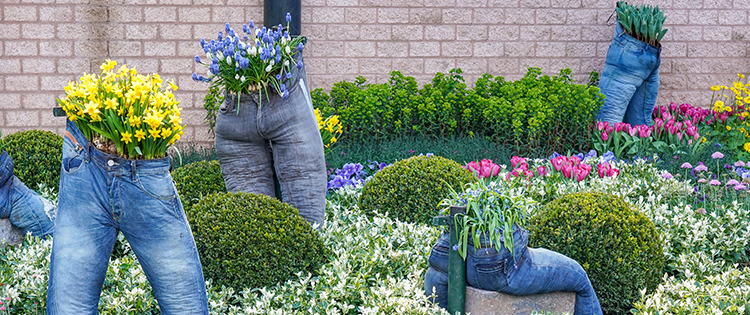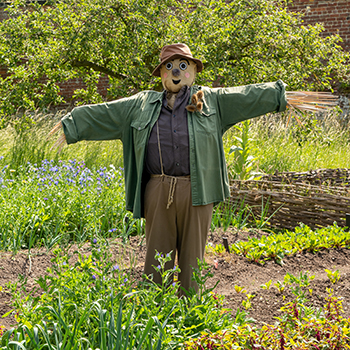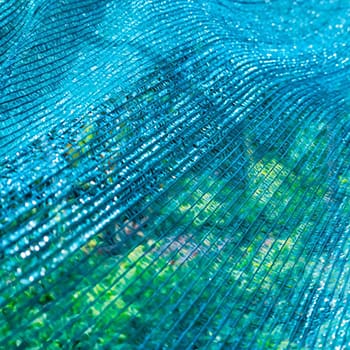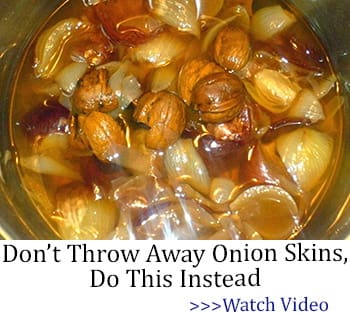Stop! Before you throw away old, holey clothes, remember that there are ways to give them another life! No, put your sewing needle down. It doesn’t have to be a quilt or anything like that. In fact, you can go ahead and use them right in your garden. How? Let’s take a look.
Planters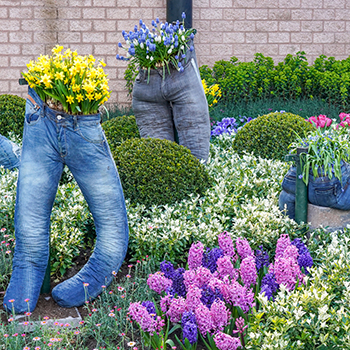
Remember those crazy upside-down tomato planters that were so popular a decade or so ago? Look, friends, I’ve been gardening a while, so if you somehow missed out on that fad? I think it’s time for you to try it.
Related: DIY Elevated Raised Bed
Using a pair of pants, tie off the bottom of each side and fill the leg with potting soil. Carefully release a small area at the bottom cuff to slide in nightshades such as eggplant or tomato. Hang them high on a clothesline pole or a tree branch; enough so that they won’t be predated upon by hornworms. You can use a belt to secure them, though I usually suggest trying to let the pants “ride” the pole if possible. Water as you would any other plant, from the top down.
Scarecrows and Other Predator-Proofing
Just the flapping of cloth can be enough to scare away many birds and small animals that are looking to make their new home in your garden. Personally, I don’t want that to be the case. This is why I plant free forage gardens for them, too, but we’ll talk about that another time. Right?
Right.
So, scarecrows. Everyone knows what those are: a large crossed set of poles that usually have a hat, some sort of shiny or skin tone face, and clothes.
Related: How To Build The Cheapest Scarecrow
You see where we’re going with this, right?
Throw your battered old clothes on a scarecrow rather than throwing them away. The sole exception for this should be those who have sun-sensitive (or petroleum-based) clothing. You can use these in other ways, but they may end up being a fire risk in some areas if the sun hits them just right and they’re at a certain stage of decomposition.
If you don’t need a scarecrow, remember that you can also use VERY brightly colored clothing instead of shiny metal discs to distract and send crows (and other birds like them) flying away. Though the birds are usually interested in natural bright colors, neon pinks and yellows (and the such) are usually associated with humans and far too scary to go check out on their own.
Lasagna Gardening Layers
If the clothing that you are intending to get rid of is made of plant-based fabric, using it in a lasagna garden is a wonderful idea! Also, if you’re interested in this type of gardening, the most plant-based fabric will break down even faster than a great deal of other brown additions will. This means that you’ll be giving plants the ability to create “nests” of fabric fibers that are left over, amazing fertilizer for them, and plenty of good matter that works into the “green” section of a lasagna garden.
Please note, however, that you should not use fabrics that are blends or those that are not plant-based. Things like rayon and whatnot are definitely not up for the task of becoming plant food and should not find their way into a lasagna garden in any way other than perhaps a scarecrow.
You may also choose to use clothing as your bottom layer rather than a newspaper, or the first layer on top of your newspaper. These are both wonderful choices that we absolutely support. However, again, keep in mind that you may do better with shredded clothing rather than whole shirts. Tear them up, help them be a true single layer, and the breakdown will work faster, better, and easier for your lasagna garden.
Shaded Areas
Shade clothes are expensive. You’re talking about hundreds or thousands of dollars to cover your garden, depending on how large of an area that you work with. Yes, it works wonderfully, but it’s still so much if you have a pile of unwanted clothes hanging around.
Related: 13 Plants That Thrive In Shade
I recommend slicing shirts and jackets in half then hanging them over your garden high above the plants and very well secured. If a rainstorm comes along, there is a good chance that the clothes may fall and squash younger seedlings and sensitive plants. Be careful if you require this kind of assistance and make sure that everything is very tightly tied down. Also, remember to go ahead and water your plants beneath your new shaded area because it is unlikely that water will get through very well as opposed to shade cloth.
Shade or sun? For these 10 plants, it doesn’t really matter. What’s so great about them is that they thrive almost anywhere (don’t expect that to be desert or extreme cold, though), in pots, inside the home, or outside, near your house, in your backyard. They don’t need much to grow quickly but they’ll offer you more than you could ask for: in this package you’ll find an herbal antibiotic, an herbal painkiller, an herbal penicillin, and an herbal narcotic. But that’s not all! Check out the entire list here.
Clean Up
To be completely blunt, the entire point of home gardening and producing our own food is to help us make less of an impact on the world around us and to make things at home. To create what we can. And to spend less and to end up with less waste, right?
You are using a ton of paper towels, aren’t you?
Let’s say that you come home from a rough day at work. You want to take out some frustration on something but you don’t know what. I’ve got the perfect plan. Go ahead and save up a pile of clothes, then on that bad day? Take out a pair of scissors and rip into them. Cut them into rags and cloths that you need to help you clean up messes, and spills, and essentially try to replace paper towels entirely.
Final Thought
This only counts if you have fabric that wouldn’t be toxic in that circumstance (look up your material against what you’ll be cleaning the first few times; most fabrics are fine but a few will react to things like bleach in very poor ways). If you do have material that is tasty, go ahead and donate it or throw it away. If you don’t? Slice up your old clothes into a beautiful new pile of easily-washed paper towel replacers that are literally made of trash that you were going to toss. Happy Reusing!
You may also like:
The Succulent Red Plant That Tastes Like Bacon (Video)
How To Repurpose Old Items Into New Projects For Your Backyard
